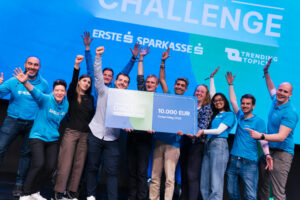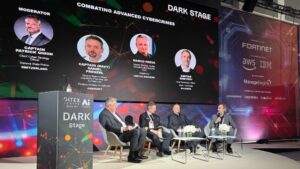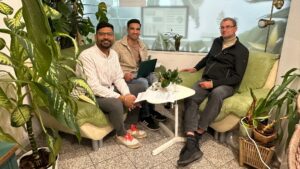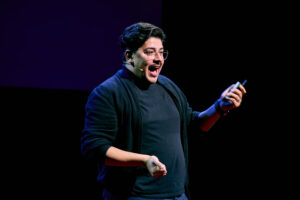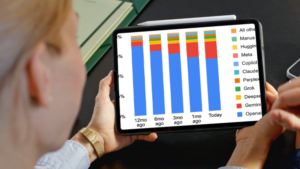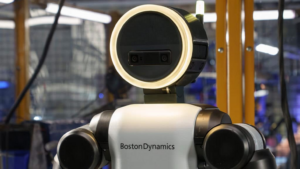Building a Financial Education App Over the Weekend: What Happened at Paysafe Mobile Hackathon 2020

Over the past weekend, Paysafe, the multinational online payments company with a product development center in Sofia, carried out the fourth edition of its annual hackathon. This year the competition took place in a virtual environment and was directed exclusively towards the development of mobile applications due to the fact that Paysafe is currently focused on the user experience (UX) with the mobile versions of its applications.
Participants had the opportunity to choose between one of the three possible challenges to develop an application – fintech as entertainment, fintech in social life, fintech for our lifestyle. Eight mentors from Paysafe were actively involved, helping participants with advice and guidance on how to create the best possible solution. At the end of the second day, all teams presented their projects to the jury.
Ultimately, the best application was delivered by Fifth Floor, a team of two iOS engineers and one UX designer, who took the grand prize of 5000 BGN.
Over the course of less than two days, Fifth Floor built an MVP of an educational solution aimed at both children and parents. In a nutshell, parents can set specific daily tasks for their children via the app. Once the tasks are successfully completed, the youngsters get financially rewarded. This way kids learn more about managing their finances through play. During the app presentation, the team showed live how parents can submit tasks, track progress, and reward their children.
After the event, Trending Topics talked to the winning team and Hristina Nedkova, Engineering Manager at Paysafe, who was part of the jury. We discussed the products created during the hackathon, the key takeaways from the weekend, and the future of mobile fintech solutions.
Trending Topics: What’s the user problem you wanted to solve with the app you built?
Petar Kanev, Aleksandra Nagornaia, Mihael Cholakov, a.k.a. Fifth Floor: Our product aims to fill the financial education void for youngsters of all ages by creating a safe and controlled simulation of an economy. The parent’s role can be any of the following: a banker, a government official, an employer, or an investment broker. A child can earn money by completing tasks like washing the dishes, doing the laundry, reading a book, etc. All earned money goes to a balance that the kid uses to deposit into a savings goal, savings, or investment account. In the case of a Saving Goal – let’s say the kid wants a PlayStation. They would create a saving goal, give it an icon, name, and target amount, and deposit money overtime to reach the goal. When that happens, the parent can complete the goal in the app and buy their kid the hard-earned PlayStation.
One of our main goals was to recreate how real-life finance works. So, there are taxes on your income, there is accrued interest on your savings account, and so on. The parent has full control of the family – for example, they could entirely disable Investment Accounts if their child is on the younger side and it’s too early for them.

Once you had an idea of what you wanted to build, how did you approach the actual development process? What was the most challenging part of the hackathon for your team and how did you overcome it?
We used to be co-workers and to this day we love working together on side projects as we share similar mentalities and passion for well-designed and thought out iOS apps. So, our team was already a well-oiled machine for developing an app from the ground up – we are two developers and a UI/UX designer. We gathered in our home, made a gigantic amount of coffee, and started tackling the tasks.
We relied exclusively on SwiftUI, which was a total breeze and it’s the main reason we were able to deliver so much in so little time. The biggest challenge probably was the backend. We initially wanted to use Apple’s own CloudKit, but we couldn’t complete a developer account purchase, as they were declining it. So we decided not to waste time and fall back on Firebase, which turned out to be the better approach for the Hackathon.
What’s the one new thing you learned during the past two days?
For some of us, the Hackathon format was a new experience. In the beginning, the energy and spirits are always high and everybody knows that those will decrease with time. What we learned and were surprised by was how well we felt in the late hours of the first day and the whole second one. We thought both body and mind would be sore, but it wasn’t that bad.
We attribute that to 3 things: liking our app – we believed we were building something we’d use as customers, enjoying each other’s company, and what might be the biggest contributor – the technology we chose to work with – it was something we don’t use at our jobs so it was new and exciting and fit the use case perfectly.
What was your favorite part of the Paysafe Mobile Hackathon experience?
Being announced a winner certainly felt pretty good. That aside we really enjoyed the creative process of coming up with the concept and the actual features. We’d be happy to meet the organizers, mentors, and other teams in person too, and get to know them better. Maybe next year…
How are you going to spend the award prize? Do you already have plans for the further development of your prototype?
We were so engulfed in the Hackathon, that we haven’t thought that much about the prize. There are a few ideas that are coming to mind like donating a computer to a family in need, treating our significant others (they’re the best), and of course – a nice dinner between us after all that coffee, sweat, and tears this last weekend. As for further development of our product — we love it and believe it can bring a lot to the AppStore table, so stay tuned :).
What excites you the most about mobile fintech solutions?
What excites us the most about Fintech is that it, on one side, is about Tech, which for us (as developers and designers) is something we’re naturally passionate about. On the other hand, you have Finance, which is something that is in the center of almost every aspect of our life. We think that being educated, smart, and responsible for your financial decisions is one of the biggest predictors of one’s success in life. This is what inspired us to work on something that can help develop healthy financial habits. Tech is something that gets bad press about how it affects people, but when paired with Finance it can guide a person to a better life.

Trending Topics: What’s the number one lesson or advice you gave to the participating teams and you’d give to any young engineer/ product manager?
Hristina Nedkova, Engineering Manager at Paysafe and part of the jury at Paysafe Mobile Hackathon 2020: If I am to give one piece of advice, this would be that you need to focus and build an MVP (Minimum Viable Product). While it may be tempting to chase multiple ideas, it is not practical to build a lot of features in a day or two. You won’t have the time to execute everything and things will not go according to your imaginary plan – organizers, mentors and other people will disturb you to socialize and make connections, things would break, you would get tired. Once you have generated the ideas for your product and features, select these that would provide the highest value.
Consider the time that is required for implementing these ideas and features and select only these that can fit in the timeframe of the hackathon. Work on two or three primary components to build a working prototype and abandon any supporting features like login, profile, info pages that bring zero value to your story, and the final pitch.
Building an MVP requires keeping your product as simple as possible. This is also valid for the technology you use and the technical decisions you take. Go for a programming language, frameworks, and platforms you know best and feel most comfortable to hack in. Technologies that give you feature richness like UI frameworks or pre-defined components also give you a competitive advantage and enable you to build a better solution.
What criteria did you use to pick the winning team? What was their competitive advantage, what impressed you the most?
Picking a winner is a really hard task. I do have experience with hackathons on all sides – participation, organization, and judging, and I would say – picking the best hack is the hardest job to take. “Being the best” is an entirely subjective assessment that varies from person to person and from event to event.
For our Paysafe Mobile Hackathon 2020, we focused on two important and fundamental things – defining clear judging criteria in advance and having the right judges. The latter can make or break the hackathon even if the best criteria are defined. That’s the reason why we selected a team of balanced and diverse jury members.
We invited Ivan Petrov, VP of Software Development at Paysafe who has tremendous experience in judging hackathons and evaluating awesomeness of products, and Dilyana Yordanova who is an incredible Product Manager, also part of our company, with an extreme focus on customer experience. We peered them with a highly technical Engineering Manager and a real geek – Deyan Danailov. And I complemented the team with my mobile experience. The best thing about the jury members was the diverse amount of skills and our ability to look at the participating products via technical and non-technical eyes and find the wow factor in both creativity and technology challenges.
The second important thing for a good ruling is the clear judging criteria. Our grading was in 5 categories:
- Functionality – We were looking for a hack that functions well and constitutes a (nearly) completed product. We rated higher feature-rich solutions. It is almost impossible to build a lot of features in a short period of time, however, having a polished working prototype is important.
- Creativity – Awesomeness is one of the best descriptions of this category. Creative, unique, and inventive ideas score high. We were looking to understand whether the product was brand new or what differentiated it from already existing solutions.
- Difficulty – This category focuses on technology and the effort for building the product. The more ambitions as scope, technology challenge, and effort to code it, the higher the score.
- Design – Beautiful products normally win the heart of the users, thus they win hackathons too. Awesome design, innovative user experience, polished look and feel – they all matter and they are the first you remember after the pitch.
- Business opportunity – The last thing we rated was the business value. We tried to project whether the product can make the users feel delighted and excited and whether the product can have a market on its own.
In addition to the categories, we defined a weight for each of them and we rated each on a scale from 1 to 10. Each team was rated at the end of their pitch. After the presentations of the teams, we reviewed the teams who had the highest score and discussed in detail what impressed us most over the other participants.
The winning team – Fifth Floor – presented an app that looked like a complete product. They built an app for children and adults that can learn to manage money via tasks, rewards, and goals. Fifth Floor’s app had a very neat, polished design, it was super user-friendly and unitive. The team presented a nice set of features in a working prototype, even had complementary ones like peering apps via QR code, dark mode, and a widget. The demo told the story of how the users would use the app in a real scenario. They scored really high in Functionality, Creativity, and Design. Personally, if there was a single app that could make me feel delighted and excited and make me ask to have it on my phone, this app would be Phyne.
Is there any specific memory or story you’d take from the 2020 edition of Paysafe Mobile Hackathon?
The whole 2020 edition of the Paysafe Mobile Hackathon was a unique experience. This was the first virtual hackathon that I participated in. There is some magic about the hackathons – being in the hall, looking at the teams who code passionately, talking to them, listening to the mentors.
Prior to the hackathon, I had concerns about how we would manage to replicate this in the online world behind the computer screen. And it just happened naturally. I spent the whole two days online via the platform. I spent almost the whole time socializing with the participants, mentors, and our team. Just like live hackathons, I met fantastic and enthusiastic engineers.
At the same time, the platform enabled me to visit the spaces of the participating teams where some of them stayed all day long and it was possible to hear and see them working. We also had our Jury and Mentors space that we used for various open conversations throughout the event.
Still, there was one crazy moment – the raffle for the presentation order. My colleague Deyan was the person who did the raffle. The streaming had 3-4 seconds delay, so I was in something like a time machine – while I was hearing Dido picking a team in the stream, in reality, next to me, he was selecting and presenting the next one.
From your perspective, what are the top emerging trends in the development of mobile fintech solutions?
I think that one of the top trends today is the continual development of Open Banking. With the PSD2, developers gained the ability to leverage APIs and develop apps and services around any financial institution. This revamped the existing market and opened it to apps that integrated multiple platforms or products into a single place for the user to manage all their financial services or transactions. As a result, fintech companies started transitioning from one business line to multiple business lines, expanding their features with wealth and investment products, and partnering with Banks to open integrated banking services. At the same time big tech players also entered the fintech scene – Google announced checking account services, Apple launched Apple Card, Uber introduced Uber Money.
In terms of mobile, fintech and banking will continue to expand to consumers via mobile due to the large distribution exposure, increased engagement and loyalty to mobile offerings, and the ability to provide quick and immediate access to products and services. Mobile and wearables also provide the ability to offer cardless payments and adopt voice commands to speed up the evolution of smart assistants in banking and investment via artificial intelligence.
What excites you the most about mobile fintech solutions?
They are mobile!
Joke aside, I have a strong passion for mobile and mobile development. According to some research, nearly 70-80% of the average time spent by users is on mobile. Apps are a driving force for developers and companies to develop flawless and innovative products and put them right in your pocket. Mobile is changing the world we live in, our habits, and the way we engage with the products we use. At the same time, fintech is a challenging industry just like mobile – the sector is fast-growing, constantly changing, and disrupting traditional products and markets. At the same time, both mobile and fintech require an extreme focus on innovation, absolute security, compliance and stability, which in turn drive technology challenges.




